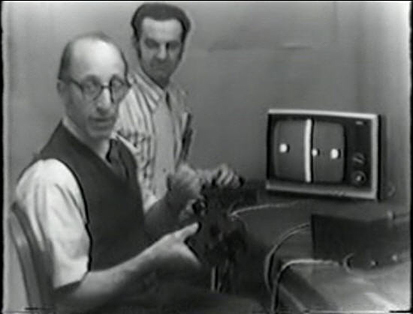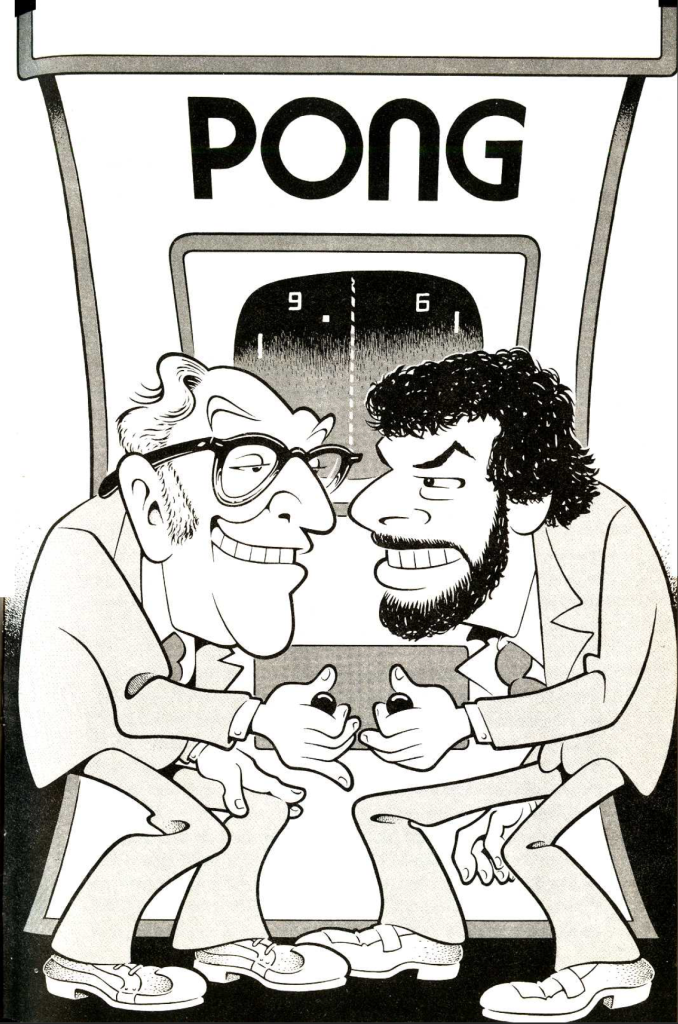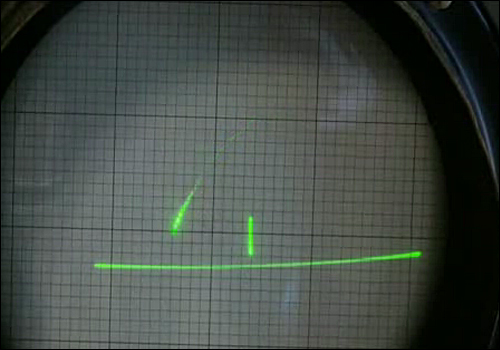This post is part of an ongoing series annotating my book They Create Worlds: The Story of the People and Companies That Shaped the Video Game Industry, Vol. I. It covers material found in the prologue on pages xviii-xx. It is not necessary to have read the book to comprehend and appreciate the post.
Choosing where exactly to start They Create Worlds was a challenge. My goal was to document most of the early experiments using a television and/or a digital computer to play a game, but starting at the chronological beginning of these efforts does not make for a compelling opening. Its great that in the late 1940s Alan Turing and Donald Michie wrote chess programs that were never implemented or that Thomas Goldsmith and Estle Ray Mann liked to pretend in the lab that a cathode ray beam might be the arc of a missile, but there is no throughline from either of these experiments to the $150 billion industry that exists today. These primordial works are examined in the book, of course, but they did not feel appropriate as a hook to draw the reader in. Clearly then, the book should not start at the beginning, but it still needed to focus on a beginning.
So I opened on a bus station in New York City on August 31, 1966, when Ralph Baer thought to himself it might be neat to control objects displayed on a television set rather than passively consuming network programming. Its nice to have a firm date like that to commence the narrative, though its not nearly so firm as one might think. Ralph Baer was a careful record keeper as befit the meticulous, detail-oriented personality that shines through in his various interviews and in his autobiographical examination of his work in the video game business. For this reason, we do know that he transformed his crazy bus station idea into a formal memo on September 1, 1966. In interviews, Baer usually stated he did so back at his office the day after his brainstorm, but the timeframe may not line up. After all, he was down from his native Nashua, New Hampshire, to meet a business client, and Google tells me that’s a good four hour trip in the modern day by car. A 1966 bus was probably taking it even slower than that. Did he really have a meeting with a client in New York City that afternoon and then immediately scurry back up to Nashua? Its not impossible, but maybe a tad improbable. Nevertheless, that’s his story, so we are sticking to it.
Whether this brainstorm happened on August 30 or August 31 though is really a minor matter of little consequence. A more important statement to analyze is the claim I make at the end of this little vignette: “But Baer was the first person to suggest creating an interactive entertainment experience by conveying game data to a display through use of a video signal, so even though he never used the term in any of his subsequent documentation or patents, he is nevertheless the progenitor of what we now call the video game.”
So there it is right? Extra, extra read all about it! Alexander Smith says Ralph Baer invented the video game! Baer himself would have certainly been pleased to see those words in print had he lived long enough to see this book published, as he always claimed the mantle “Father of Video Games” and defended that title against all comers. Repeatedly. And in detail. I don’t begrudge him any of that: the man was absolutely a key cog in the transformation of video games from backroom lab experiments to mass market entertainment, and he lived in the shadow of Nolan Bushnell much longer than he deserved. But did he really, truly invent the video game or have a valid claim to its paternity? Well, despite my glib pronouncement in the prologue of the book, the answer is a little more complicated.

Before ruling on Baer’s case, we must decide what the heck constitutes a video game anyway. Ralph Baer would tell us there is a simple technical definition we can go by: if you are playing a game on a screen and that game data was conveyed to said screen by a video signal, then you have a video game; otherwise you don’t.
So then what is a video signal? A video signal is a modulated electromagnetic wave that conveys image data, with the frequency of the wave determining the chrominance, or color, of the image and the amplitude defining the luma, or brightness. This signal provides instructions to the cathode ray tube (CRT) of a television, which focuses a stream of electrons on a single point on a phosphor-coated screen, causing a sustained glow at that point. A magnetic field generated by coils within the CRT allows this beam of electrons to sweep back and forth across the entire screen, one horizontal line at a time, to create a complete picture from this collection of individual dots according to the parameters of the incoming signal. This is the process Baer is describing when he tells us a video game must, by definition, use a video signal.
Right away, Baer’s definition presents a problem by excluding a set of early products that were widely defined by the public and within the industry as video games in their own time: coin-operated vector games like Atari’s Asteroids (1979). The graphics in these games are drawn by a vector generator that takes direct control of the CRT and instructs it to aim at a specific point on the screen and then move on a specific vector until a command is given to deflect the beam in a different direction. The CRT is still receiving and responding to a signal, but it’s not a video signal. There is no doubt, however, that even the most conservative modern definition of a video game would include Asteroids, so Baer’s simple straightforward technical definition must already be set aside.

But once we open up the definition, where do we stop? Well, we have to include the vector games clearly, so it logically follows that any time a player interacts with images drawn by a CRT, it counts as a video game. But why stop at a CRT? Modern video games played on a high-definition television or monitor hooked up to a PlayStation 5 or an IBM PC Compatible certainly must count too. While Baer hews to an old-school definition of a video signal that presumes an analog system, digital displays are also driven by a video signal, albeit in a slightly different way. The prime difference between the two is that a digital signal consists of a series of ones and zeroes that provide instructions to draw a complete bitmapped image all at once rather than the analog method in which the image is drawn one scanline at a time. These digital images are pulsed to the television at a specific, constant frequency that determines how many times a second the display will be updated with a new image, the so-called “frame rate” as measured in frames per second (FPS) that is the obsession of high-end graphics connoisseurs. Its still video, so it counts.
So now we know we have a video game whenever someone interacts with objects on a screen, right? Well, not exactly. One problem with merely focusing on the screen is that in the coin-op world, games with “screens” of one form or another existed as early as the 1920s through the use of film projectors. What do we do with driving simulators like Auto Test (1954), shooting games like Nintendo’s Wild Gunman (1974), or even the Nutting Associates Computer Quiz (1967), all of which use a film projector to display images with which the player interacts?
Furthermore, what do we do with old computer games that outputted data to a teletype or some other display that does not incorporate a screen? Baer would tell us these are “computer games” rather than “video games” and that these are overlapping, but not identical, categories. Practically speaking, this feels like a meaningless distinction. After all, if one plays Adventure (1977) on a teletype instead of a CRT terminal, is this truly a different experience considering the computer executes the same code and the game proceeds in an identical manner either way?
Fellow video game historian Ethan Johnson and I pondered this topic at length, and he came up with a critical discriminating element. He did a whole blog post about this, but the relevant portion is as follows:
“[R]ather than needing a certain sort of signal, a display for a video game must be arbitrary. This means the display as a whole has to have a direct relation to the program underlying it and is able to achieve a number of different states rather than just “on” or “off”. In the early tic-tac-toe games for instance, while an individual state of a square only has a boolean value, the board as a whole has hundreds of different possible outcomes which are ultimately not pre-determined. The individual state of a screen in Computer Quiz only has two possible variables: Light on or light off, and therefore can not be said to be using a display in the same way as video games.”
Well that does for Computer Quiz at least, but it does not necessarily answer the question for a more complex game like Wild Gunman, and it only gets us a little closer to solving the conundrum of games on early computer systems that lacked a CRT. Furthermore, by opening up our definition to include all computer games with an arbitrary display, we are forced to address how to treat analog computing devices like the Nimatron displayed in 1940 at the World’s Fair, or Claude Shannon’s chess-playing Caissac machine from 1949. These are unquestionably both computers that play games, but does that really make them video games too? Do we now extend the history of video games all the way back to 1912 and the Spanish El Ajedrecista chess-playing automaton? Clearly, we need to establish some other limiting criteria.

The easiest way to distinguish these edge cases from video games is to distinguish between the internal components that generate the game elements. A game like Wild Gunman uses electro-mechanical components, that is wipers, switches, and contacts facilitate the completion of electrical circuits to create playfield action by powering relays, steppers, and other mechanical parts. All video games by the Baer definition, including his own Magnavox Odyssey and Atari’s Pong (1972), use electronic components instead, with streams of electrons directed through a series of logic gates determining what happens over the course of the game. This allows us to distinguish not only electro-mechanical coin-operated games with screens from video games, but also allows us to remove early electro-mechanical analog computing devices from the equation.
Now that we have defined two critical technological elements, we need to add a couple of conceptual components to complete our working definition of the term video game. First, we need to define the user’s place in this interplay between logic circuits and a display. The easiest way to do this is focus on the commonly accepted definition of “playing a game,” which requires active participants rather than passive viewers. For video games, this means the game needs to unfold through direct user interaction via a control scheme allowing the players to directly manipulate objects on the display. There is really no need to elaborate on this element any further: so long as this interaction is happening, the how of it is unimportant.
Finally, we need to define exactly what interactions between a user, some electronic logic, and a display constitute playing a game. If we don’t, then a word processor or a DVD menu is just as much a video game as Pong. The best we can do here is define a video game, which is generally understood to be a leisure activity, as a product intended to provide entertainment. This is the most subjective part of our definition because different people find different things entertaining and even a DVD menu could be turned into a game by a particularly bored individual. The best we can do is point to the intrinsic purpose of the product as determined by authorial intent. If the program was produced or marketed with the primary goal of entertaining a person, then its a game. If the entertainment value is secondary to serving some other function, then it’s not. This is not a perfect test. For example, a product primarily designed to educate might also be deliberately crafted to entertain to hold the user’s interest. More work needs to be done on this element of the definition to clarify gray areas, but I will leave that for others to work out.
Now we have a serviceable, though still imperfect, definition of a video game that eliminates many, though not all, of the edge cases: A video game is an entertainment product played on a device containing electronic logic circuits in which the players interact with objects rendered on an arbitrary display.
So now that we have identified the child, who is the father? There are a few ways to look at this. One is to employ our newly articulated definition and look for the first product that meets all these criteria. That might lead us to 1947 and the prototype cathode-ray tube amusement device (CRTAD) patented by Estle Ray Mann and Thomas Goldsmith. I personally feel CRTAD does not really hold together under our definition of a video game, but that is a discussion for another time and another annotation. Regardless, I feel comfortable ruling that these two engineers are not the fathers because they probably never built a finished product, certainly never displayed the system publicly, and did not influence any of the projects that came afterwards. By the same logic, we can also dismiss the dueling chess AIs created by Michie and Turing in 1948, which were complete computer programs on paper, but were never implemented on an actual computer.
So if the first conceived games do not make the cut, what about the first fully operational and publicly displayed product? That would lead us to Bertie the Brain, a custom tic-tac-toe computer built by Josef Kates and demoed in 1950. There is no doubt that this is the earliest known publicly played device that meets all our criteria for a video game, but is being first really all its cracked up to be? Bertie was displayed at a single Canadian trade show and received virtually no press. It may have been played by a decent number of people — the show draws over one million attendees every year — but it did not stick in the collective memory and was only rediscovered by scholars in the 2010s. Furthermore, it was solely intended to demonstrate the workings of a new type of vacuum tube and was not marketed as a new form of entertainment. Once again, I think our father — an appropriate term only because all our early pioneers in this field were men — needs to do more than bring a simulation into the world; he needs to understand he is creating something that could change the face of entertainment. Clearly, Kates wanted the attendees to be entertained while using his computer, but that is not quite the same thing.
So how about that master of physics and entertainment, “Wonderful Willie” Higinbotham? There is a solid case to be made that his tennis game, retroactively dubbed Tennis for Two (1958) by historians, marked the first time a video game was created solely to entertain the public. Therefore, he is our first real contender for the title “father of video games.” Once again though, I believe we need to exclude him because he did not start a wider movement. Our father is no good to us if his child failed to have children of its own.
So what about the first entertainment program that could be acquired by the general public? Right now, the earliest known game to fit that definition is a baseball simulation created by IBM employee John Burgeson in 1960-61 and briefly requestable as part of the program library for the IBM 1620 computer before being withdrawn from the catalog in 1963. There are a couple of problems here. First, this program only barely meets our definition of a video game because the only player interaction happens at the beginning when creating a team by selecting from a pool of players. More importantly, it appeared and vanished so quickly that it failed to have any sort of impact.
Then maybe its Steve Russell et al. and their Spacewar! (1962), which certainly achieved popularity across a select group of universities and research institutions and itself birthed the first commercial video game, Computer Space (1971)? Now I think we are getting closer. Baer would discount this game because it uses a point-plotting display, which functions in essentially the same manner as a vector monitor except that instead of drawing lines it draws each point individually. As Baer might say, “no video signal, no video game.” But we have already moved past that narrow definition. The main strike against the game is that it did remain confined to a small number of locations and was not commercialized. One could argue that since video games did not capture the imagination of the general public until commercial models were available that anyone could gain access to for a reasonable price, then our father needs to be someone that brought video games into the mass market. I find that argument flimsy, but it can be made.

So now we come at last to the final two contenders, Ralph Baer and Nolan Bushnell. Among the general public, I think the debate really comes down to just these two. The controversy over which of them birthed the video game has literally existed for as long as people have written about video game history, with Steven Bloom’s monograph Video Invaders debating this very topic as early as 1982. Both have strong claims to the title. Nolan Bushnell came to market first with Computer Space, but Ralph Baer started work on his system earlier and had largely completed it by 1968. Bushnell also debuted the first successful product, Pong, but the game only came about because he saw the table tennis game on the Odyssey.
Which person one prefers really depends on how you define the parameters. Is it first conceived that matters or first released? Is it enough to dream up a system, or does said system also need to capture the public’s imagination? Certainly Baer and Bushnell themselves expended most of their energy trying to prove who came up with the idea of commercializing video games first during a series of patent lawsuits in the 1970s. Baer, with that meticulous streak, was able to provide a plethora of verified documentation from 1966-72 elucidating every step along the way from initial spark to final product. Bushnell could only counter this by claiming he wrote a paper in college in the 1960s about playing games on a computer after he saw Spacewar!. When asked to submit the paper as evidence, he proved unable to do so. The courts rightly sided with Baer, but winning a patent suit is not quite the same thing as winning a paternity suit.

So now that we have a video game definition and a list of the major contenders for our parental figure, is Ralph Baer the “progenitor of what we now call the video game”? Not really. I feel the video game really has two sets of parents, Russell and friends, who created the first video game to gain a significant following across multiple installations, and Bushnell and his partner Ted Dabney, who were inspired by the work of the Russell group to engineer the first commercial video game product. This leaves Baer the odd man out despite the pride of place I gave him in the book. Baer himself would have certainly not been pleased to see these words in print had he lived long enough to see this blog post published. That said, he really was the first person to follow through on the idea that manipulating objects on a standard television set could be fun; he was the first person to realize it was possible to create a hardware system to do so that was cheap enough it could be commercialized for home use, and he worked out how to interface this hardware system with a television set using an RF modulator and a video signal. These were the building blocks upon which the entire home video game industry was built, and that in itself is a monumental achievement. So while I am not entirely comfortable calling Baer the “father of video games,” I will gladly cede him the title “father of the video game console” and give him pride of place at the beginning of my three-volume history. Baer’s bus stop brainstorm may not have been the beginning, but there is no doubt it was quite a beginning.
They Create Worlds: The Story of the People and Companies That Shaped the Video Game Industry, Vol. I 1971-1982 is available in print or electronically direct from the publisher, CRC Press, as well as through Amazon and other major online retailers.







